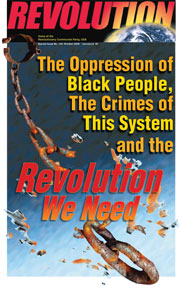Student Correspondence:
700 March at Loyola University, Chicago, in Support of Mizzou Struggle
November 16, 2015 | Revolution Newspaper | revcom.us
We received the following from T.L., a student at Loyola University in Chicago:
Nationwide, colleges and universities have been responding to the events that have recently taken place at the University of Missouri. The explosion of protests, demonstrations, and rallies across the country in the past year have revived the talk about racism and systemic oppression in institutions and society. The students at the University of Missouri, mostly black, demanded new leadership in their administration, and they called for colleges and universities across the nation to stand with them. Loyola University Chicago was one of those schools. Being a private, Jesuit institution, Loyola portrays itself as a place of diversity and a place where social justice is held to a high degree. Though there is some diversity on campus and opportunity to participate in social justice affairs, Loyola has its problems, especially when it comes to the inclusiveness of students of color on campus.
Loyola University, Chicago, November 12. Photo: Special to revcom.us
Several days before the events at the University of Missouri, the leaders of the Black Cultural Center, an entity on campus for black students, called for a meeting with all the black students on campus. The meeting was called “Color My Loyola: A Reformation.” We talked about diversity on campus and representation of African-Americans on campus and in administration. As a first-year student at Loyola, I was shocked at how many problems black students faced on campus, especially in the classrooms. I was even more shocked at the fact that most of the issues addressed were systemic and micro aggressive issues. The meeting was empowering and brought awareness of the various issues at Loyola.
After the events at the University of Missouri had taken place, the black student leaders on campus called for a demonstration in solidarity with the University of Missouri. On Thursday, November 12, at 1:50 pm, students left their classes and walked towards the front of Cudahy Library and the Information Commons for the demonstration. As I was walking towards the crowd of people, I became overwhelmed with emotion at how many students there were. I was expecting it to be no more than 100 people; 700 people showed up to the demonstration. I was amazed at how many non-blacks were there.
At the beginning of the demonstration, we were yelling chants and just enjoying the moment of black unity. One of the black student leaders started to talk about the demonstration and why we were there. Then other student leaders spoke on the different issues at Loyola, such as, of course, the systemic oppression and targeting of students of color on campus, the underrepresentation of students of color on campus and in administration, the not-so-great decisions made by administration, and other issues on campus.
After some time into the demonstration, standing in the middle, I looked around and saw all of the people there and felt very empowered and heard. The most memorable part of the demonstration was when one of the leaders of the demonstration yelled the word “Ashé,” which is a statement of agreement, and the crowd would respond by yelling “power.” The word “power” was screamed so powerfully, it echoed throughout the entire campus. There probably was not one spot on campus where you could not hear the word “power” being yelled.
I also will not forget the speech of Heather Afriyie, a black senior at Loyola. Her powerful voice spoke volumes, which left a lot of the black students in tears. After Heather’s speech, the call and response “Ashé” and “power” was done once more, and the march around campus began.
The march was very powerful, yet very demanding. A plethora of chants were yelled and everyone felt a sense of unity and empowerment. We first stopped by the president of Loyola’s office. The black leaders compiled a list of demands that the black population and the other students of color would like to be done. That list was read and given to the president. After that, we marched around the campus and a part of the neighborhood Loyola borders. We were supported by the honking of cars riding past and residents in the apartments of the neighborhood peeking out there windows cheering us on.
Loyola University, Chicago, November 12. Photo: Special to revcom.us
Our final stop was the East Quad in front of the Damen Student Center, where one of the administration offices is. We locked arms and created a huge circle around the quad. The black students were called to the middle of the circle, and all of the non-black students cheered and clapped for us, which was a great overwhelming feeling. Finally, some of the black students, including myself, went into the administration office in the student center to read off the second list of demands and hand it to the administrators. The students who did not go inside stayed in the quad to continue demonstrating. Their chants could be heard very clearly from inside the building.
Overall, this experience was very empowering and showed what unity and solidarity can do for changing society and promoting justice and equality. I was born and raised in Ferguson, Missouri, and I witnessed first-hand what happened there. This experience was a lot similar to the demonstrations in Ferguson that were not shown in the media. I believe that society is progressing towards the right path. Racism and systemic oppression is coming more and more into the light, and hopefully society will continue to progress.
Volunteers Needed... for revcom.us and Revolution
If you like this article, subscribe, donate to and sustain Revolution newspaper.







